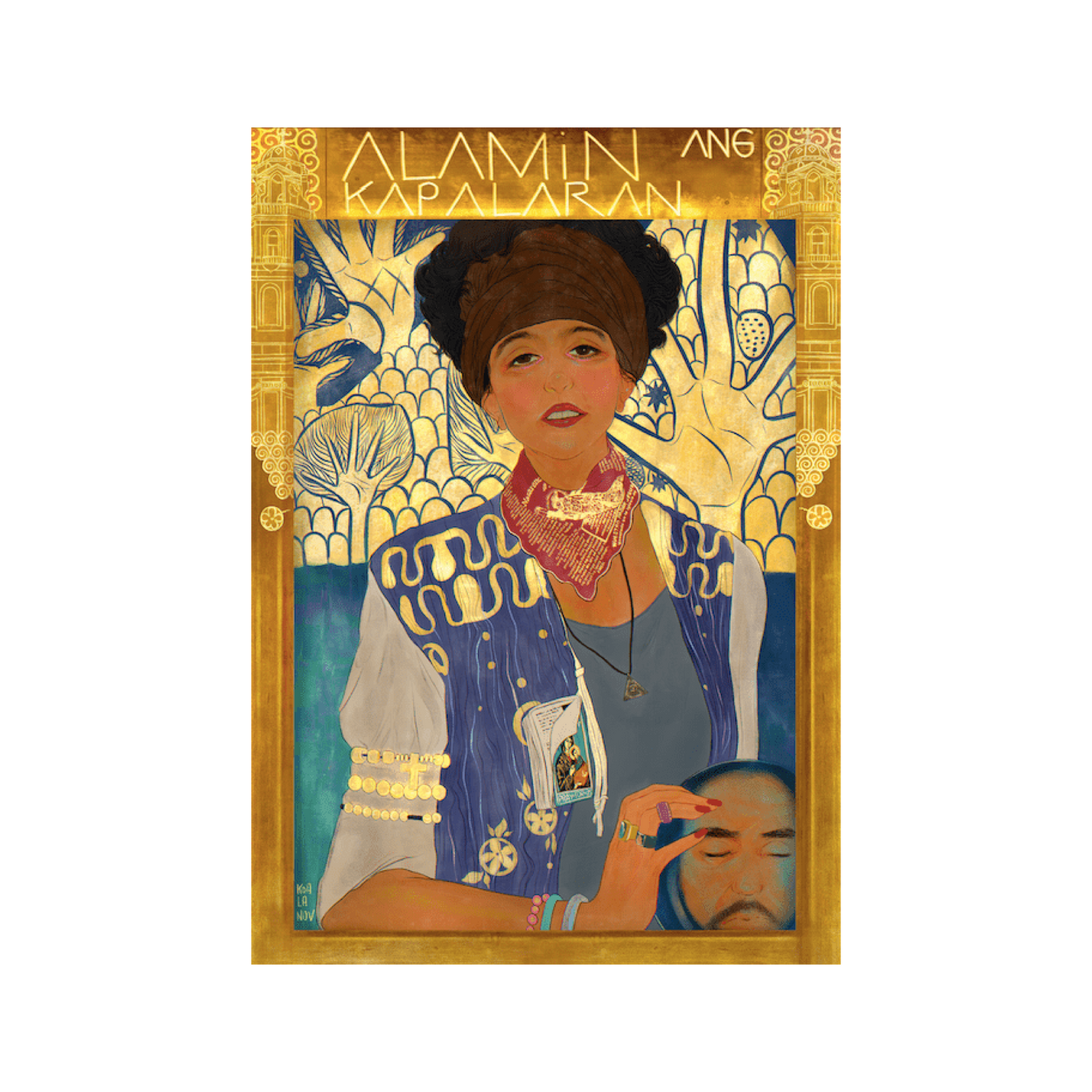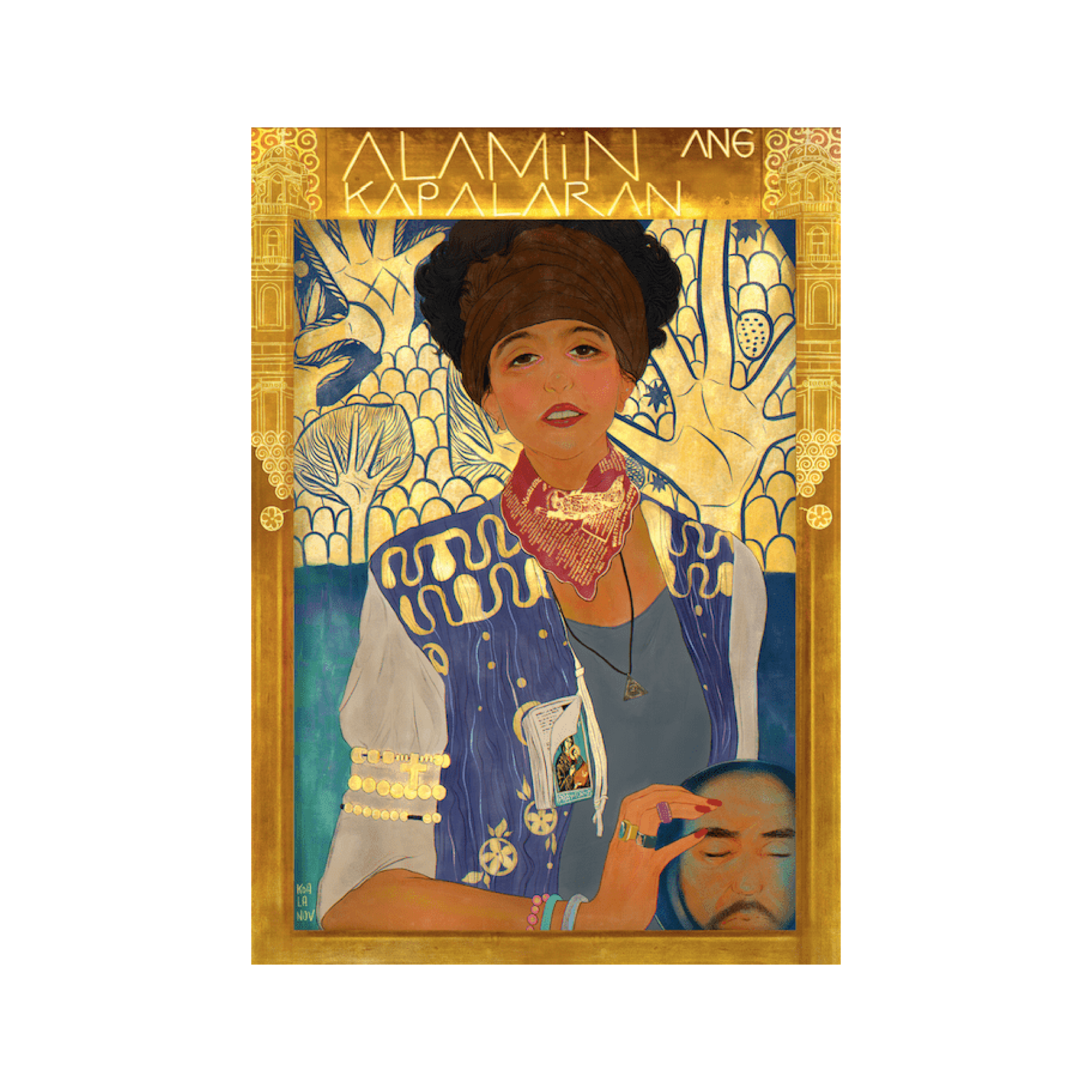Ang Manghuhula sa Plaza Miranda (The Fortune Teller in Plaza Miranda) by Koalanov
Ang Manghuhula sa Plaza Miranda (The Fortune Teller in Plaza Miranda) by Koalanov
Ang Manghuhula sa Plaza Miranda (The Fortune Teller in Plaza Miranda) is derived from Gustav Klimt’s version of the iconic Western painting Judith and the Head of Holofernes. The famous art has been rendered and interpreted by many artists from the Renaissance period as well as in Modern art. Judith’s depiction, specifically from the Renaissance has often been one of comedic role reversal, sourced from the irony of a femme-fatale triumphing over a powerful male figure in the context of a largely patriarchal European society. This specific trope in art has also been closely associated with the depiction of women being involved in witchcraft in the 15th century, lending an air of danger and mysticism to more common associations of women (desire, sexual allure etc.) during that period in history.
This association with witchcraft and mysticism with women successfully made its way into the shores of the Philippine islands during the Spanish colonisation period. Shamans in many Filipino ethnic groups, called Babaylans, acted as powerful figures in pre-colonial Filipino society and these positions were predominantly dedicated to women, and in rare cases, feminine men (called asog or bayok). With the introduction of Christianity to the Philippine islands, Spanish colonisers made a concerted effort to demonise the pre-colonial pagan religions within the Philippines, accusing the revered Babaylans of witchcraft and violently persecuting all who practice paganism in the islands.
In modern times, the influence of paganism and mysticism in the Philippines exists in many fragmented manifestations throughout the islands. While ethnic tribes who successfully survived the Spanish colonization still exist within the Philippines, modern Filipinos still have a strong penchant for mysticism and superstition. The Manghuhula (“Fortune-teller”) who ply the streets of Quiapo, Manila is one such example. They are modern day mystics who read palms, tarot cards and tell one’s fortune in exchange for a small fee. They flock around Quiapo Church, a basilica that houses “The Black Nazarene'' a dark statue of Jesus that many Filipinos believe to have miraculous powers. The Manghuhula gather around the church in their belief that the Black Nazarene give them the power they require to ply their trade and like the Babaylans of old, the Manghuhula of Quiapo are predominantly women. While many Filipinos treat the Manghuhula with an air of respect and caution, the Manghuhula are also often depicted as charlatans in Filipino pop culture, thus their status in a now Patriarchal modern Filipino society is precarious at best.
The artist has chosen to depict Judith from Gustav Klimt’s Judith I as a “Manghuhula of Quiapo”, as a woman surrounded by an air of mysticism and danger. In her view Klimt’s depiction of Judith in his work Judith I is the most striking. Judith in Klimt’s work is not the heroine, nor is she the harbinger of God’s salvation like most of her depictions in the Power of Women trope. In Judith I she is disrobed, wearing finery in rich gold and blue, arresting the viewer with her steely gaze. The artist sees Judith I not as a comedic reversal of Patriarchal themes but an overt obliteration of it. Similarly she wanted to depict the Manghuhula in her interpretation of Judith I as a similar triumph. Filipino mysticism did not die in the face of 300 years of Spanish colonization, it merely evolved.
Couldn't load pickup availability
Product Details
Product Details
Giclée Fine Art Print (SGD 300)
Limited edition of 100, hand-numbered, unframed
Comes with Certificate of Authenticity
310gsm Textured Fine Art Paper (100% Cotton, Acid-Free, Archival)
42 x 59.4cm (A2)
Year Created
Year Created
2021
Artwork Inspired By
Artwork Inspired By
Judith and the Head of Holofernes (also known as Judith I) (1901) by Gustav Klimt
About The Artist
About The Artist
Ivee Pendo, known as Koalanov, is a Filipino artist and illustrator depicting scenario-based artworks often portraying the lives of modern Asian women. With a degree in Computer Engineering and no formal art education, she created a line-work style that still follows realistic approach and discipline in order to produce truthful forms in human nature. She tends to use warm and saturated colours that radiate in watercolour treatment that overall taps into nostalgia.
Art for her is liberating when it requires no explanation from the artist. She’s not always an outspoken person nor has the patience to transmute it into clever sentences, so for her, art is the sieve through which her thoughts, ideas and intuition can run unimpeded, unanalysed or unexplained. “Art can simply often be considered what ideas or concepts her art represents, based on the thematic and aesthetic devices she used to bring her art to bear. In truth my art is simply the contents of my head, released freely onto the canvas.”
Artist Country
Artist Country
- Philippines
Shipping Information
Shipping Information
Free self-collection within Singapore is available for all orders.
Free local delivery is available for orders over SGD$100.
Free international delivery is available for orders over SGD$200.
As all our art prints are produced on demand to reduce waste, we appreciate your patience regarding our production times. Please contact us if you need an order expedited for reasons such as gifting purposes.
For more information on shipping rates and delivery times, please see our shipping policy.
Return & Refunds
Return & Refunds
Please see our Refund Policy for more information.



